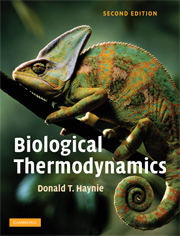Book contents
- Frontmatter
- Contents
- Preface to the second edition
- Chapter 1 Energy transformation
- Chapter 2 The First Law of Thermodynamics
- Chapter 3 The Second Law of Thermodynamics
- Chapter 4 Gibbs free energy – theory
- Chapter 5 Gibbs free energy – applications
- Chapter 6 Statistical thermodynamics
- Chapter 7 Binding equilibria
- Chapter 8 Reaction kinetics
- Chapter 9 The frontier of biological thermodynamics
- Appendices
- A General references
- B Biocalorimetry
- C Useful tables
- D BASIC program for computing the intrinsic rate of amide hydrogen exchange from the backbone of a polypeptide
- Glossary
- Index of names
- Subject index
- References
B - Biocalorimetry
Published online by Cambridge University Press: 05 June 2012
- Frontmatter
- Contents
- Preface to the second edition
- Chapter 1 Energy transformation
- Chapter 2 The First Law of Thermodynamics
- Chapter 3 The Second Law of Thermodynamics
- Chapter 4 Gibbs free energy – theory
- Chapter 5 Gibbs free energy – applications
- Chapter 6 Statistical thermodynamics
- Chapter 7 Binding equilibria
- Chapter 8 Reaction kinetics
- Chapter 9 The frontier of biological thermodynamics
- Appendices
- A General references
- B Biocalorimetry
- C Useful tables
- D BASIC program for computing the intrinsic rate of amide hydrogen exchange from the backbone of a polypeptide
- Glossary
- Index of names
- Subject index
- References
Summary
Introduction
Calorimetry is the only means by which one can make direct, model-independent measurements of thermodynamic quantities. Spectroscopic techniques, though in many cases extremely sensitive or useful for obtaining high-resolution structure information, can give but an indirect, model-dependent determination of thermodynamic quantities. Calorimetric analysis therefore complements spectroscopic studies, giving a more complete description of the biological system of interest. Modern microcalorimeters are both accurate and sensitive, so that measurements require relatively small amounts of material (as little as 1 nmol) and can yield data of relatively low uncertainty.
Diffuse heat effects are associated with almost all physico-chemical processes. Microcalorimetry provides a way of studying the energetics of biomolecular processes at the cellular and molecular level, and it can be used to determine thermodynamic quantities of conformational change in a biological macromolecule, ligand binding, ion binding, protonation, protein–DNA interaction, protein–lipid interaction, protein–protein interaction, protein–carbohydrate interaction, enzyme–substrate interaction, enzyme–drug interaction, receptor–hormone interaction, and macromolecular assembly. Microcalorimetry is also useful in the analysis of thermodynamics of very complex processes, for example, enzyme kinetics and cell growth and metabolism. Calorimetry is not narrowly applicable to processes occurring at equilibrium.
There are three broad classes of biological calorimetry: bomb calorimetry, differential scanning calorimetry (DSC), and isothermal titration calorimetry (ITC). Other biocalorimeters are usually derivatives of these types. The choice of instrument will ordinarily depend on the process of interest. Bomb calorimetry is used to measure the energy content of foods and other materials; discussion of the technique can be found in Chapters 1 and 2.
- Type
- Chapter
- Information
- Biological Thermodynamics , pp. 372 - 377Publisher: Cambridge University PressPrint publication year: 2008



